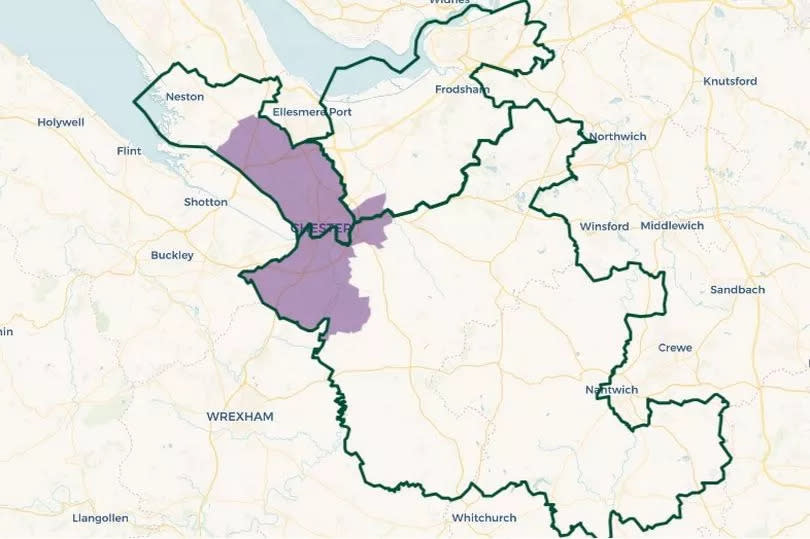Chester's constituency split: Why it happened and what it will mean for the next election

The political landscape will look very different in Cheshire after July 4, whatever the outcome of the general election. The City of Chester constituency was abolished in the latest boundary review.
Ninety per cent of constituencies underwent some boundary change in the 2023 review. Constituencies must be within 5 per cent of the ‘electoral quota’, a number arrived at by dividing the number of registered UK voters by 650 seats in Parliament.
In 2023, that number was 73,393 registered voters. The review brought dramatic changes for Cheshire, not least for the county town.
READ MORE: 'Time to turn the page on Tory chaos' Angela Rayner tells Macclesfield residents | Angela Rayner was on the campaign trail in Macclesfield with Labour candidate Tim Roca
READ MORE: Education secretary Gillian Keegan visits Crewe on the campaign trail for Tories | Gillian Keegan said Crewe has 'experienced a rise in educational standards' under the Conservatives
The city will be represented by two MPs for the first time since 1885 after the City of Chester. Chester’s new constituencies see the city split along the River Dee, with the abolished constituency split into three.
The new constituencies are Chester North and Neston, Chester South and Eddisbury, and Runcorn and Helsby. Here, we analyse the make-up of those new constituencies, and what past elections could tell us about July 4.

Chester North and Neston
75.1 per cent of the City of Chester’s electorate will be voting for an MP to represent the Chester North and Neston constituency. The successor constituency stretches from the northern banks of the Dee, including Great Boughton, roughly to the A55 in the West and to the Welsh border in the east, all the way to Parkgate and Willaston in the north.
Neston, Parkgate and Willaston were previously part of Ellesmere Port and Neston, also an abolished constituency. 23.2 per cent of this constituency will be folded into Chester North and Neston.
While the City of Chester had been represented by both Conservative and Labour politicians, changing from the latter to the former in 2015 and being held by Labour by a majority of 6,164 at the last election; Ellesmere Port and Neston has been held by Labour since 2010, with Labour gaining a majority of 8,764 votes at the last election in 2019.
At the 2023 local elections, 15 of the councillors elected to wards in the new Chester North and Neston constituency were Labour, with just 3 councillors representing other parties — Conservatives representing the Saughall and Mollington ward and the Willaston and Thornton ward, with an independent councillor representing Parkgate.
Chester South and Eddisbury
23.5 per cent of former City of Chester voters now live in the Chester South and Eddisbury constituency. The successor constituency runs along the Welsh border, following the south bank of the River Dee, incorporating Handbridge, Lache and Huntington, and Chester communities roughly south of Tarvin Road.
These Chester communities will be represented by the same MP as villages as far away as Audlem, 20 miles from Lache, and closer to Stoke-on-Trent than to Chester. At the 2023 local elections, the area returned two Labour councillors and four Conservatives, including in the Farndon ward, parts of which were represented by the City of Chester constituency.
The vast bulk —58.9 per cent— of the new Chester South and Eddisbury constituency is drawn from Eddisbury, with the rest made up of areas previously part of Weaver Vale (Labour hold in 2019) and Crewe and Nantwich (Conservative gain in 2019). Eddisbury has been won by vast Tory majorities since its creation in 2010, the narrowest being 12,974 in 2015, when Antoinette Sandbach won the seat.
Ms Sandbach had the Conservative whip removed after voting with opposition MPs on a bill that would delay the UK’s departure from the EU. She was one of 21 MPs expelled from the party, joining the Liberal Democrats 7 days before the 2019 General Election, won by Conservative Edward Timpson.
Runcorn and Helsby
A tiny lobe of the former City of Chester constituency has been given over to the new Runcorn and Helsby constituency. The new constituency takes swathes of the former Halton and Weaver Vale constituencies, as well as parts of Neston and Ellesmere Port and Eddisbury.
Runcorn and Helsby takes a tiny chunk —1.3 per cent— of the former City of Chester constituency, roughly north east of Vicars Cross comprising Guilden Sutton and Pipers Ash. The electorate of Weaver Vale makes up 51.2 per cent of the new constituency, a marginal constituency held by the Conservatives from 2010 to 2017, when it was won by Labour and held in 2019.
Mike Amesbury won the seat by just 562 votes at the last election. 37.1 per cent of the new constituency’s electorate previously voted in Halton, represented by Labour’s Derek Twigg from 2010 to its abolition in 2024.
Mr Twigg is Labour candidate for Widnes and Halewood at this year’s general election.
NEWSLETTER: Sign up for CheshireLive email direct to your inbox here

 Yahoo News
Yahoo News 
